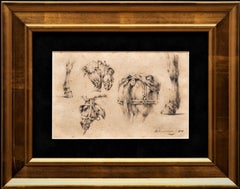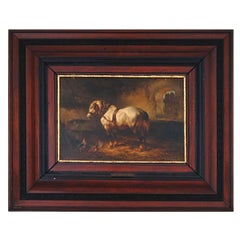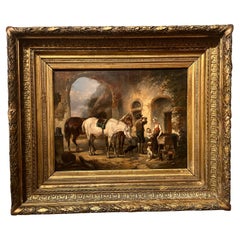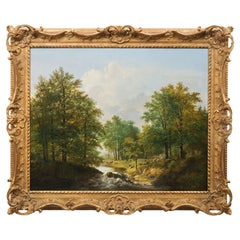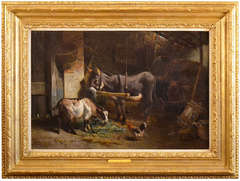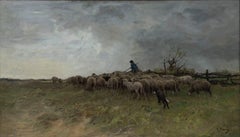Wouterus Verschuur
Antique Horse "Heads, Hooves, Rump 1838" Wouterus Verschuur (Dutch, 1812-1874)
Located in SANTA FE, NM
Antique Horse Study
"Heads, Hooves and Rump, 1838"
Wouterus Verschuur (Dutch, 1812-1874)
Pencil on
Category
1830s Romantic Animal Drawings and Watercolors
Materials
Pencil, Paper
Antique Horse Study; Legs and Rumps, 1838" Wouterus Verschuur (Dutch, 1812-1874)
Located in SANTA FE, NM
Antique Horse Study
"Legs and Rumps, 1838"
Wouterus Verschuur l (Dutch, 1812-1874)
Pencil on paper
Category
1830s Romantic Animal Drawings and Watercolors
Materials
Pencil, Paper
Work Horse Oil Painting by Wouterus Verschuur I
Located in New York, NY
, Wouterus Verschuur I (1812-1874). Panel measures 9 by 13 inches and its period ogee frame with gillded
Category
Antique Mid-19th Century Dutch Romantic Paintings
Materials
Wood
19th Century Wouter Verschuur original oil painting
By Wouterur Verschuur
Located in Scottsdale, AZ
believed to be one of his early works. Wouterus Verschuur belongs to the last generation of Dutch Romantic
Category
Antique Early 19th Century Danish Baroque Revival Paintings
Materials
Paint
Landscape Painting "Shepherd & Flock" by Pieter Gerardus Van Os circa 1821
Located in Shippensburg, PA
Berchem. From his studio in Amsterdam, Pieter taught such notable pupils as Wouterus Verschuur, Simon van
Category
Antique 19th Century Dutch Romantic Paintings
Materials
Canvas, Paint
$12,000
H 32 in W 37.25 in D 3 in
Recent Sales
'In the Barn'
Located in Amsterdam, NL
famous colleague Wouterus Verschuur. Many art connoisseurs nowadays even think the quality of
Category
19th Century Romantic Animal Paintings
Materials
Oil
Landscape with shepherd and a flock of sheep
By Anton Mauve
Located in Ede, NL
animal painters P.F. van Os and Wouterus Verschuur. He also worked for a time in the Gelderland village
Category
Late 19th Century Impressionist Landscape Paintings
Materials
Canvas, Oil
"The Farewell" - Late 19th-Century Antique Landscape Painting, Framed
Located in New Orleans, LA
information about the artist:
"Wouterus Verschuur (11 June 1812 - 4 July 1874) was a Dutch painter of animal
Category
Late 19th Century Romantic Figurative Paintings
Materials
Oil
A Winter Scene, Alexis De Leeuw, 1848 – 1883 Bruges, Belgian Painter, Signed
By Alexis De Leeuw
Located in Knokke, BE
genre’, to which Wouterus Verschuur (1812 – 1874), Dutch painter of anima belonged in The Netherlands
Category
19th Century Romantic Animal Paintings
Materials
Canvas, Oil
H 49.22 in W 40.16 in D 5.91 in
Girl with basket and kitten in a barn
By Anthony Mauve
Located in Veendam, NL
worked in Pieter Frederik van Os’ studio. Subsequently he was apprenticed with Wouterus Verschuur. While
Category
19th Century Interior Paintings
Materials
Oil
People Also Browsed
Antique Dog Painting Collies in Horse Stable w/ Saddle and Blanket, 19th century
Located in SANTA FE, NM
Antique Dog Painting "Collies in Horse Stable with Saddle and Blanket"
Auguste Vimar (French 1851-1916)
Circa 1900
21 x 17 1/2 (29 x 25 1/2 frame) inches
An excellent depiction of c...
Category
Early 1900s Realist Animal Paintings
Materials
Canvas, Oil
$10,000
H 28 in W 25.5 in D 4 in
Shipping in Stormy Waters, Attributed to Italian Artist Francesco Guardi
By Francesco Guardi
Located in Stockholm, SE
The splendour of the tragic sea
Francesco Guardi and maritime painting in Venetian art
No Venetian painter was a stranger to the sea. After all, Venice was not only one of the mos...
Category
18th Century Old Masters Landscape Paintings
Materials
Canvas, Oil
$47,982 Sale Price
32% Off
H 25.79 in W 29.14 in
A Game Of Cards, 19th Century by Henry George Sharp (1834-1900)
Located in Blackwater, GB
A Game Of Cards, 19th Century
by Henry George Sharp (1834-1900)
Large 19th Century interior scene of a St Bernard, Jack Russell Terrier and a King Charles Spaniel at a cards table...
Category
19th Century Animal Paintings
Materials
Canvas, Oil
Barbizon School Painting, Jules Dupré "Landscape by the River", Oil on Canvas
By Jules Dupré
Located in Montreal, Quebec
Rare, large and very beautiful oil painting by Jules Dupré (1811-1889), a French artist famous for his dramatic paintings of forests around Paris and one of the leaders of the Barbiz...
Category
Antique 19th Century French Barbizon School Paintings
Materials
Canvas, Wood
$118,400 Sale Price
20% Off
H 29.5 in W 33.25 in D 3.5 in
C19th Portrait Princesse de Joinville of Brazil - Spectacular fit for a palace
By Henri d'Ainecy Montpezat
Located in London, GB
Portrait of Princess de Joinville riding a Bay Horse
Henri d’Aincy, Le Comte Monpezat (French 1817-1859)
Painted circa 1837-9
oil on canvas
113 x 92 inches (including frame)
92 x 70 ...
Category
1830s Old Masters Portrait Paintings
Materials
Oil
18th century oil sketches for a Baroque interior - a pair
Located in London, GB
A FEAST OF THE GODS WITH VENUS AND BACCHUS
Collections:
With Appleby Brothers, London, June 1957;
Hazlitt, Gooden & Fox, London, 1961;
John and Eileen Harris, acquired from the abo...
Category
Early 18th Century Baroque Figurative Paintings
Materials
Canvas, Oil
$245,229
H 36 in W 48.13 in
Ophelia, Victorian 19th Century Royal Academy Oil Painting
Located in London, GB
Oil on canvas, signed lower right
Image size: 33 1/2 x 56 1/2 inches (85 x 143 cm)
Original gilt frame
Provenance
With the artist's son, Millie Dow Stott Esq., until 1912.
Artist...
Category
Late 19th Century Victorian Figurative Paintings
Materials
Canvas, Oil
$136,768
H 33.5 in W 56.5 in
'Cock Fight in Cuba' original Regionalist painting signed by John Steuart Curry
By John Steuart Curry
Located in Milwaukee, WI
John Steuart Curry
"Cockfight in Cuba," 1946
oil on canvas
Image: 38.25 x 46.25 in
Frame: 43.75 x 51.5 in
Signed on reverse with initials JSC on lower right stretcher bar
John Steu...
Category
1940s American Realist Figurative Paintings
Materials
Canvas, Oil
$1,087,500
H 43.75 in W 51.5 in
Reply of the Zaporozhian Cossacks to Sultan Mehmed IV Painting after Ilya Repin
By Ilya Repin
Located in Queens, NY
Reply of the Zaporozhian Cossacks to Sultan Mehmed IV of the Ottoman Empire, also known as Cossacks of Saporog Are Drafting a Manifesto.
Late 19th Century.
Monumental oil on ca...
Category
Antique Late 19th Century Russian Paintings
Materials
Canvas
$60,000 Sale Price
60% Off
H 80 in W 123 in D 5 in
Double Portrait Oil Painting Brothers George, 2nd Duke Buckingham & Lord Francis
By (After) Anthony Van Dyck
Located in London, GB
Aftrer Anthony VAN DYCK - maybe Studio (1599, Antwerp – 1641, London) Flemish
Double Portrait of George Villiers, 2nd Duke of Buckingham (1628-1687) & Lord Francis Villiers (1629-164...
Category
17th Century Old Masters Portrait Paintings
Materials
Oil
$112,105
H 66.93 in W 57.88 in
My Lady of the Rose Portrait of Hilda, the Artist's Wife - British oil painting
Located in London, GB
This superb British exhibited portrait oil painting is by noted artist George Spencer Watson. The influence of Lord Frederick Leighton and the Italian Renaissance can easily be seen....
Category
1910s Pre-Raphaelite Portrait Paintings
Materials
Oil
$168,157
H 51 in W 41 in D 2 in
19th Century sporting horse portrait oil painting of a racehorse with spaniels
By George Henry Laporte
Located in Nr Broadway, Worcestershire
George Henry Laporte
British, (1802-1873)
Best of Friends
Oil on canvas, signed & indistinctly dated
Image size: 27.25 inches x 35.25 inches
Size including frame: 34.25 inches x 42....
Category
19th Century Victorian Animal Paintings
Materials
Canvas, Oil
$13,032
H 34.25 in W 42.25 in D 2.5 in
A Fine and Charming 19th Century Oil Canvas "Children Walking the Baby Goat"
Located in LA, CA
Henry Joseph Campotosto (Belgium, 1833-1910) A Very Fine Oil on Canvas "Walking the Baby Goat", depicting two young dutch girls by the grassy shore of a river bank, one standing hold...
Category
19th Century Academic Figurative Paintings
Materials
Oil
$47,500
H 39.63 in W 31.75 in D 2.25 in
"Polly in White"
By Rae Sloan Bredin
Located in Lambertville, NJ
Jim’s of Lambertville Fine Art Gallery is proud to offer this piece by Rae Sloan Bredin (1881 - 1933).
Rae Sloan Bredin, short lived at only fifty-two years of age, was unquestionab...
Category
20th Century American Impressionist Portrait Paintings
Materials
Oil, Canvas
The Bather by Childe Hassam
By Childe Hassam
Located in New Orleans, LA
Childe Hassam
1859-1935 American
The Bather
Signed and dated “Childe Hassam” (lower right)
Oil on canvas
Considered by many to be America’s foremost Impressionist painter, Childe...
Category
20th Century Impressionist Nude Paintings
Materials
Canvas, Oil
Monumental Oil Canvas, Georges Henri Fauvel, Hunting Dogs with Master, 19th Cent
Located in Manhasset, NY
Monumental Oil Canvas, Georges Henri Fauvel, Hunting Dogs with Master, 19th Cent
A very large and impressive painting hanging 139 by 89 inches having a group of finely detailed hunt...
Category
Antique Late 19th Century Paintings
Materials
Canvas, Paint
$57,500
H 89 in W 139 in D 3 in
Get Updated with New Arrivals
Save "Wouterus Verschuur", and we’ll notify you when there are new listings in this category.
